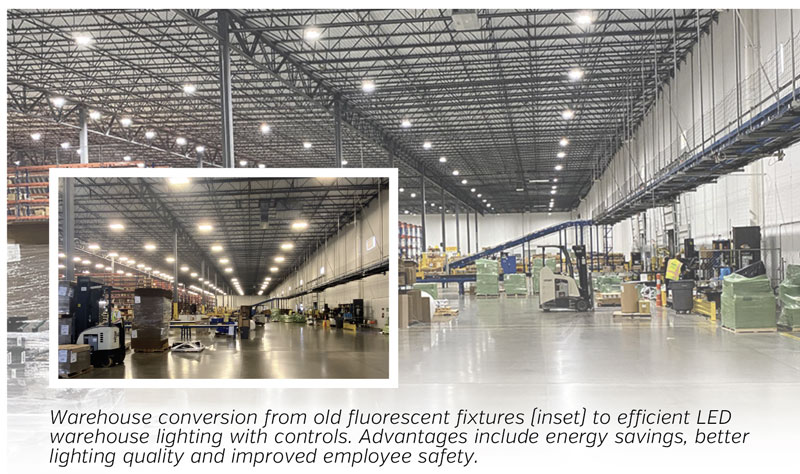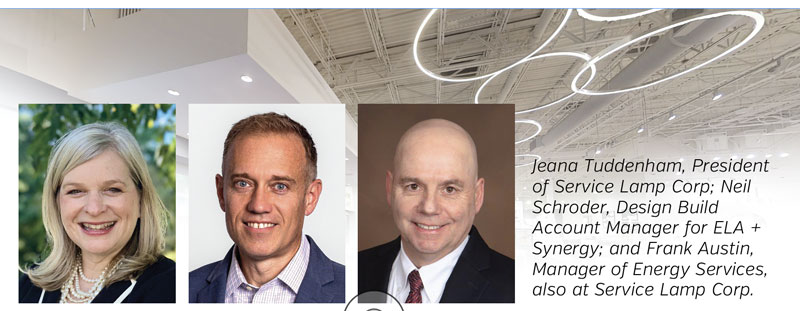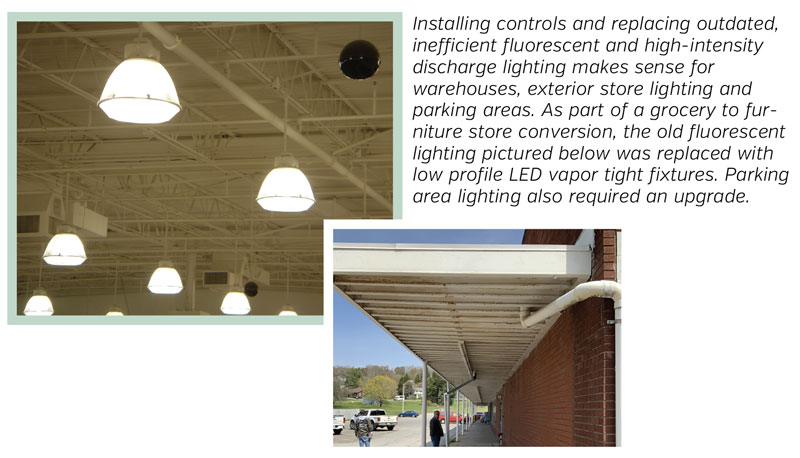Interview with Jeana Tuddenham, Neil Schroder & Frank Austin
Updating
inefficient lighting
and installing
controls helps
furniture retailers slash costs, meet
sustainability goals, improve aesthetics and enhance
worker safety.
The July/August edition of Furniture World presented numerous ways home furnishings retailers can embrace
circular and
sustainable practices. This time, we continue our coverage of sustainable facilities management with a
discussion of
store lighting with Jeana Tuddenham, President of Service Lamp Corp; Neil Schroder, Design Build Account Manager
for ELA
+ Synergy; and Frank Austin, Manager of Energy Services, also at Service Lamp Corp.
Why Lighting Controls?
“The reasons why furniture retailers might want to install lighting control systems,” said Jeana Tuddenham,
whose
company supplies lighting fixtures, lighting controls, consulting services and lamps (bulbs), “are to help meet
sustainability and carbon neutral goals and to cut electricity costs. Lighting in typical furniture stores is
responsible for a significant portion of total electricity usage, so the savings can be substantial.
“For some stores, controls make sense; for others, they don’t. If you’re IKEA or City Furniture, controls make
sense,
but if you’re Joe’s Furniture Store with one 20,000-square-foot store, probably not.
“In most retail stores, with the exception of grocery stores with freezers and refrigerators, lighting accounts
for
about 53% of electric operating costs. But in furniture stores, it’s higher—due to all the tracks—bringing the
average
up to around 60% to 65%. If a store has converted to LED lighting and does it with controls, so that lighting is
used
when and where it’s needed, then the percentage will be lower.”
Do Controls Make Sense?
“Whenever retailers consider installing lighting controls for their showrooms, warehouses, administrative
offices or
exteriors,” added Schroder, who represents manufacturers of lighting fixtures and controls, “they are trying to
find
ways to reduce illumination. Dimming a 40-watt fixture by 50% saves 20 watts per hour. That relationship makes
dimming a
powerful way to produce cost savings.”
“Whenever retailers consider installing lighting controls for their showrooms, warehouses, administrative offices
or exteriors,” added Schroder, who represents manufacturers of lighting fixtures and controls, “they are trying
to find ways to reduce illumination. Dimming a 40-watt fixture by 50% saves 20 watts per hour. That relationship
makes dimming a powerful way to produce cost savings.”
The question for retailers is determining where and when automatically dimming lighting makes sense. Service
Lamp’s
Frank Austin pointed out that “retailers face two conflicting goals. First, they want to reduce lighting levels
to
achieve the lowest operating costs. The second consideration, which trumps the first, is that shoppers must be
able to
view merchandise in a way that inspires them to buy. Showroom display lighting consumes the highest percentage
of energy
in any furniture store operation, but dimming the lights isn’t an option while shoppers are in the store. And
for most
stores, neither is harvesting daylight from windows or skylights.”

Small but Easy Savings
“However, there are other simple and inexpensive control options retailers can consider,” noted Austin.
“The worst thing that can happen regarding lighting in a furniture showroom with 2,000 15-watt or 20-watt track
heads is
for someone to close up the store at the end of the day and forget to turn them off. It also doesn’t make sense
to fully
illuminate showrooms when staff members are the only people in the store. We suggest installing a basic level of
control
that maintains a base showroom lighting level of about 10 foot-candles of illumination when employees are
prepping in
the morning or shutting down the store in the evening. That allows them to move around safely and do their work
when
showroom track lighting is turned off. Once the store opens to shoppers, the track lighting is set to provide
maximum
illumination automatically.”
"A dimmed fixture rated for 50,000 hours could last 70,000 or 80,000 hours due to minimizing the thermal load
over
time.”
Larger Savings
Tuddenham, Austin and Schroder agreed that for most furniture retailers, bigger opportunities to reduce energy
usage lie
beyond the showroom floor in the warehouse and back-of-the-house areas.
“That,” said Schroder, is where retailers can add controls to achieve savings while making these areas safe for
employees and highly efficient.
“I recommend a high-low warehouse lighting strategy that automatically dims lighting to about 10% as a background
level,
saving maximum energy until someone enters the space. That avoids fixtures cycling on and off, which reduces the
life of
the small solid-state drivers found in LED fixtures or individual lamps. Keeping this background level of
illumination
also improves employee safety. For example, someone working behind a box scanning barcodes can easily find
themselves in
the dark should a sensor fail to see them. And then, of course, overnight, when the warehouse shuts down, the
controls
turn all the lights off. It’s a multi-layered approach.”
“For some stores, controls make sense; for others, they don’t. If you’re IKEA or City Furniture, controls are
necessary,
but if you’re Joe’s Furniture Store with one 20,000-square-foot stores, probably not.”
Old, Inefficient Warehouse Lighting
“In new furniture warehouse construction, more than likely, these capabilities are designed in.” Schroder
continued.
“When upgrading old, inefficient warehouse lighting from pressure sodium or metal halide to new, efficient LEDs,
storeowners should consider adding warehouse lighting control occupancy capability to maximize their savings.
There are
three different levels:
-
Level 1: Each fixture has a sensor programmed to adjust light dimming based on
occupancy. It provides full illumination
when it senses that a person or piece of equipment has entered an area.

-
Level 2: These are fixtures with sensors that can be grouped. For example, should an
order picker enter a row with racks
on either side, all the fixtures on one side are programmed to turn on, then dim that side when that
picker leaves. This
balances safety considerations with energy efficiency.
-
Level 3: The next level adds more technology—an app that calculates energy savings and
controls HVAC systems and
lighting. Smart systems anticipate energy needs and adjust systems to ensure optimal efficiency, safety
and customer
comfort. They are data-driven, set-it-and-forget-it systems featuring dashboards and sophisticated
granular reporting.
“Smart systems anticipate energy needs and adjust systems to ensure optimal efficiency, safety and
customer
comfort.”
Payback Period
“Converting to LED always makes sense,” Austin explained, “ but deciding to replace or upgrade lighting systems
with
controls most often depends on estimates of return on investment. We use software that factors in the cost of
various
upgrades, utility rebates, tax reductions, local energy costs and other considerations.
“My experience is that if there’s a three-year or faster payback, 70% of retailers will install controls. If the
payback
period is four years, that number goes down to about 30%.
Outdoor Controls: “Quality outdoor lighting has long-term positive effects on retail furniture
store businesses,” added
Tuddenham. “I’m talking about lighting building exteriors, including entryways and parking lots. When shoppers
enter a
store, it’s part of the experience, a prelude to seeing beautifully lit home furnishings.
“A large majority of furniture stores that have switched to LED lighting in showroom areas may still use
fluorescent and
high-intensity discharge lighting in their warehouses, office areas, showroom exteriors and parking lots, which
use a
lot of energy. “In showrooms with light fixtures placed every three feet on center, over areas of 25,000, 35,000
or
45,000 square feet, there’s considerable electrical usage. In contrast, outdoor lighting is a minor expense for
retailers who have already converted to LED with photosensor dusk-to-dawn time-of-day controllers positioned on
the top
of each light. But it’s a different situation for furniture retailers that still operate high-intensity
discharge
lighting. A high-intensity discharge light is 458 watts, whereas warehouse LEDs are roughly 75 watts.”
Office Areas: “In office areas of buildings, replacing fluorescent fixtures that consume 150
watts each with LED
lighting that pulls 30 or 40 watts represents substantial savings as a percentage of total energy usage for
those
administrative areas,” Tuddenham added.”
Other Considerations
Schroder mentioned that although ROI drives many of these decisions, other factors should be considered,
including state
regulations that ban the sale of replacement fluorescents, incandescents and high-intensity discharge/metal
halide
lamps.
Regulations: “December 31, 2028,” he noted, “is the last time in the USA that anyone can
purchase replacement
fluorescent bulbs with end pins. Canadian regulations kick in a year later. Once federal regulations go into
effect,
these older fixtures will effectively be banned. The primary benefit of taking these lamps off the market will
be to
reduce environmental mercury exposure. Reduced power consumption will be a secondary benefit.”
Extended Life: “Another consideration is that dimming with controls has the added benefit of
extending fixture and lamp
life. A dimmed fixture rated for 50,000 hours could last 70,000 or 80,000 hours due to minimizing the thermal
load over
time. Even dimming by 10% can double the life of an LED fixture or lamp with a solid-state driver rated for a
maximum
temperature of 104 degrees Fahrenheit. When the temperature exceeds that, it can cut the driver’s life in half.”
“Even adding a simple manually operated wall box dimmer to reduce track lighting levels,” said Austin, “can
reduce the
frequency of changing out fixtures and lamps, but it’s something hardly anyone does. As Neil described earlier,
it’s not
as good a solution as adding automation to control showroom lighting, but it’s still worth considering.”
“We can now deliver high-quality light that brings out the color of home furnishings items
and also changes the color temperature throughout the day.”
Advanced Controls & the Future of Retail Lighting
Color Temperature & Light Level: Tuddenham explained that a best practice for showroom lighting is to illuminate
products close to how they will appear in customers’ homes. “That requires using LED spots and floods to
highlight
products at a static color temperature and spectrum. The Color Rendering Index (CRI) should show colors
naturally to
mimic lighting conditions in a typical house. The average house has a Kelvin temperature of about 2900.”
Cancellations / Revenue Churn
Cancellations of written sales, also known as revenue churn, kills cash flow
and lowers financial performance. For this reason, it makes sense to track
cancellations, understand why they happen, and implement processes that will
lessen revenue churn.
Austin agreed. “When people buy furniture, they don’t want to be shocked because it doesn’t look the same at home
as at
the point of sale. So, when we design lighting systems, we’ll specify between 3100 to 3300 Kelvin for general
light and
2700 Kelvin for accent lighting. We try to get a blended CRI so that a maroon leather sofa purchase is less
likely to
look washed out to brown when delivered to a home.
“But in the next five years or so, we will see a wider introduction of adaptive home lighting that adjusts light
level,
color temperature and brightness throughout the day continuously to render morning, afternoon and evening
natural light.
“Ambient lighting affects human circadian rhythms, which in turn have been found to affect sleep, mood and other
mental
functions. As this aspect of health and wellness finds its way more fully into homes, we may need to match that
in
stores. One could also imagine that furniture departments or room vignettes could be bathed in ambient light
correlated
with optimal purchasing behavior.”
Playing With Light: “In this regard,” said Schroder, “companies like Lutron are pushing the
envelope. There are many
ways to play with light. We can now deliver high-quality light that brings out the color of home furnishings
items and
also change the color temperature throughout the day, or, for example, elicit an emotional response that makes a
space
feel a certain way.
“There are so many possibilities. High-end controls can be used to saturate specific frequencies of colors with
color-tuning technology. These are already being installed in art galleries or entertainment venues to unleash
the full
spectrum of what’s possible to create more dynamic spaces.

“Residentially, commercially, and in the retail and hospitality markets, there’s a push to use lighting that
provides
more than mere functionality. Lighting can make spaces feel important and inviting, so customers stay longer,
feel
better and are more likely to buy. We’re on the front side of a wave, which will be a big deal. Retailers will
have more
flexibility to highlight products better or adjust the mood of a space using an app for a grand opening,
customer
appreciation or sales event. For example, control technology might be used in a design center to help clients
see how
furniture will look under different lighting conditions,” concluded Schroder.
In closing, Tuddenham reminded Furniture World’s readers that although furniture retailers must plan for the
future,
many still need to catch up. Old technologies add costs and result in less-than-optimal illumination. “Making
the right
decisions,” she said, “requires expertise to specify the right fixtures and lamps and to make cost-effective
decisions
regarding upgrading to programmable sensors that dim individual lights or a complete lighting control system to
achieve
maximum efficiency and safety.”
Questions about this article can be directed to Jeana Tuddenham via
editor@furninfo.com.